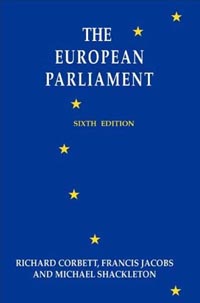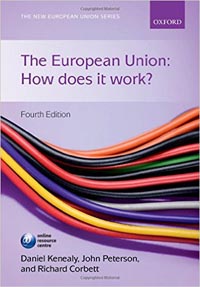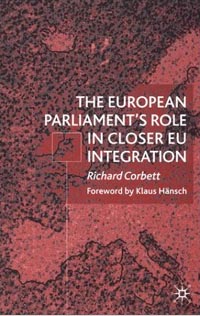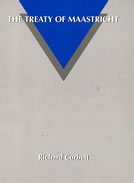
The European Parliament
Richard Corbett is the Member of the European Parliament for Yorkshire and Humber. He is the Deputy Leader of the European Parliamentary Labour Party and serves on the Constitutional Committee of the European Parliament. Richard has been active in European politics for more than 30 years, being directly involved with many of the key transformations of the European Union during a period of unprecedented expansion.
The European Parliament is considered to be the standard reference work on the world's first experiment in transnational democracy, an institution that brings together elected representatives from all member states of the European Union. Currently in its ninth edition, the textbook is written by Richard Corbett together with Francis Jacobs and Darren Neville.

Developing in tandem with closer economic integration, the European Parliament is extending its influence over political decisions that are being taken beyond the national level. Responding to a decision-making process in the European Union that often takes place behind closed doors, the European Parliament has come to represent a viable means to ensure public participation in issues affecting the entire community.
The institutional structure and range of powers available to the Parliament are explored in three main sections of the book. Three introductory chapters to The European Parliament provide an historical context, explain the electoral process, and describe the day-to-day functioning of the Parliament. The following chapters focus on the role of individual members of Parliament, how groups of members are organized, and how the Parliament is led. This section also examines the Parliament's committee structures, its plenary sessions, its secretariat, and the growing phenomenon of intergroups.
The remaining chapters of The European Parliament discuss the influence of the European Parliament and how its current powers have evolved over the course of three decades since direct elections were first held in 1979. These powers are discussed in terms of the traditional functions of parliamentary bodies for participation in the legislative process, the appropriation of expenditures, oversight of the executive, and serving as a forum to articulate public concerns.
In addition to performing traditional legislative roles, the European Parliament exerts significant influence on the development of Europe's constitutional system. As Europe continues its journey towards closer integration, its Parliament is the key to maintaining momentum along this route by strengthening its role within the European community as a whole.

The European Union: How Does It Work? is a university textbook that provides a scholarly and practical introduction to the institutions that make up the European Union. This collection compiles work from leading experts who have first-hand experience in their fields, while covering a comprehensive range of relevant topics with in-depth knowledge and analysis.
As Europe adapts to continuing changes in its structure and focus, its institutions provide the foundation for responding to the demands of economic and political integration, as well as its relationship with the global economy. The latest edition of this textbook addresses current topics relating to the fiscal and monetary policy implications of the Eurozone single currency area, and the challenges posed by popular scepticism to the European Union within the United Kingdom.
Contributing experts featured in The European Union: How Does It Work? communicate a deep understanding of their topics in a scholarly and accessible style, while directly taking on many of the hard issues that confront the European Union in the present day. Together, the selections provide highly engaging perspectives to both the theory and practice of one of the most successful models of international cooperation in history.

Addressing this continuing evolution, The European Parliament's Role in Closer EU Integration is a comprehensive examination of the Parliament's influence in the successive renegotiations of European treaties and its proposed constitution. The book also considers the development of current European policies through the parliamentary process. Richard Corbett assesses the practical achievements of the European Parliament twenty years after it was first conceived, comparing these achievements to those that were originally envisioned.
Having participated in the process of drafting the Treaty of Maastricht, the Treaty of Amsterdam, and the proposed European Constitution, Richard Corbett offers valuable first hand knowledge of one of the most complex and multifaceted ongoing political processes of our time, that of European integration.
European integration has progressed during a half century, with its Parliament becoming an integral part of this process during the last two decades. The European Parliament's Role in Closer EU Integration, based on the Corbett's doctoral thesis, explores the impact that this elected body has had on the process of European integration.
The book begins by defining what is actually meant by European integration, examining the theoretical framework around which numerous treaties and institutions are based. Corbett goes on to describe the original intentions for establishing an elected Parliament to become part of the process of political and economic integration.
The European Parliament has undertaken to achieve institutional reform within the European Union. This book describes the Parliament's efforts to revise existing treaties and its influence on the creation of new treaties including the Single European Act, the Treaty of Maastricht, and the proposed European Constitution. The role of elected representatives is examined, in part to determine whether new political relationships have been created within the European body, and what influence European parliamentarians have had on the respective member states and European institutions.

The Treaty of Maastricht led to the creation of the European Union, succeeding the European Community as a result of separate negotiations on monetary union and political union. The treaty also established the creation of a common currency, the Euro, and introduced the three-pillar structure relating to Economic and Social Policy, a Common Foreign and Security Policy, and Justice and Home Affairs. This book by Richard Corbett offers a complete guide to the Maastricht process, covering its initial conception, negotiations and ratification.




